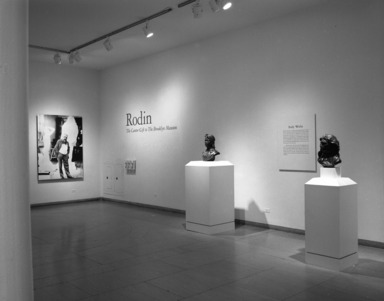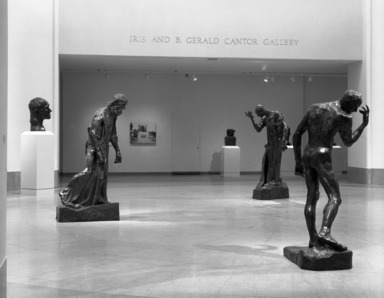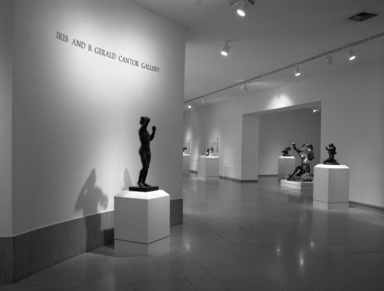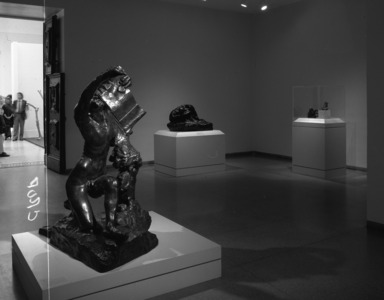

Rodin: The Cantor Gift to The Brooklyn Museum, March 1, 1988 through April 18, 2024 (Image: PHO_E1988i012.jpg Brooklyn Museum photograph, 1988)

Rodin: The Cantor Gift to The Brooklyn Museum, March 1, 1988 through April 18, 2024 (Image: PHO_E1988i013.jpg Brooklyn Museum photograph, 1988)

Rodin: The Cantor Gift to The Brooklyn Museum, March 1, 1988 through April 18, 2024 (Image: PHO_E1988i014.jpg Brooklyn Museum photograph, 1988)

Rodin: The Cantor Gift to The Brooklyn Museum, March 1, 1988 through April 18, 2024 (Image: PHO_E1988i015.jpg Brooklyn Museum photograph, 1988)

Rodin: The Cantor Gift to The Brooklyn Museum, March 1, 1988 through April 18, 2024 (Image: PHO_E1988i016.jpg Brooklyn Museum photograph, 1988)

Rodin: The Cantor Gift to The Brooklyn Museum, March 1, 1988 through April 18, 2024 (Image: PHO_E1988i017.jpg Brooklyn Museum photograph, 1988)

Rodin: The Cantor Gift to The Brooklyn Museum, March 1, 1988 through April 18, 2024 (Image: PHO_E1988i018.jpg Brooklyn Museum photograph, 1988)

Rodin: The Cantor Gift to The Brooklyn Museum, March 1, 1988 through April 18, 2024 (Image: PHO_E1988i019.jpg Brooklyn Museum photograph, 1988)
Rodin: The Cantor Gift to The Brooklyn Museum
-
Auguste Rodin
Auguste Rodin (1840–1917) occupies a pivotal position in the history of sculpture. Straddling two centuries, his life’s work takes its place in the tradition established by the French Academy (whose standards reflected long-standing classical ideals of sculpture) while at the same time setting the stage for important twentieth-century innovations. He strove for success within the established framework of government-sponsored exhibitions and commissions yet refused to compromise his unconventional ideas about art.
Although Rodin worked with the traditional materials of sculpture (clay, plaster, bronze, and marble), he handled them in an entirely new way. Instead of trying to smooth away evidence of the sculptural process, he often chose to retain the seams, tool marks, fingerprints, breakage, and excess deposits of the medium. Similarly, although many artists of the nineteenth century admired the sculptural fragments of antiquity, none before Rodin dared to create a partial figure and declare it a self-sufficient work of art. Rodin purposely omitted elements, such as arms, not essential to the expression he sought to achieve—something his contemporaries found difficult to accept. Nonetheless, his consistent use of the human figure attests to his respect for, and commitment
to, tradition.
While Rodin often took allegorical, mythological, literary, or historical themes as his subject, his goal in portraying them marked a significant departure from his predecessors. Like the Symbolist writers and artists who were his contemporaries, he sought to communicate the invisible by means of the visible. Character, emotion, and thought could all, he felt, be read in the pose, expression, and physical structure of a figure. Rodin believed that nature, being a creation of God, could produce only beauty: he who saw ugliness in nature saw wrong. Whereas age, deformity, and accident were banished from the Academic canon of beauty, Rodin proclaimed that these had their place and that true artists transformed such aspects into eloquent affirmations of nature’s splendor.
The multifaceted character of Rodin’s art, its simultaneous endorsement and disavowal of cherished Academic principles, places him at the nexus between tradition and modernity in sculpture. The implications of Rodin’s ideas fueled many interesting and important developments in the twentieth century, earning him the well-deserved title “father of modern sculpture.”
The sculptures by Auguste Rodin on display here were given to the Brooklyn Museum by the Iris and B. Gerald Cantor Foundation. -
The Burghers of Calais
In the wake of its humiliating defeat at the hands of Prussia in 1870, the French Third Republic sought to reinvigorate notions of heroism and citizenship. To this end, in 1884 the city council of Calais commissioned Rodin to create a monument to Eustache de Saint-Pierre. In 1347, while Calais was under siege by the English, Eustache and five other important citizens of the town had offered themselves as hostages, pleading for mercy for their long-suffering city.
In his first maquette of 1884, Rodin proposed a conventional monument, with his figures united as a group on a tall pedestal. By the following year, however, the six figures were placed on a low rectangular plinth, at the same level as the viewer. As Rodin later wrote: “I wanted to have my statues placed in front of the Calais city hall on the very paving of the square like a living rosary ofsuffering and sacrifice.”
Rodin first made nude figure studies, which he then draped in wet canvas to model the sackcloth worn by the burghers when theysurrendered. To create the most expressive figures possible, he used the radical technique of combining studies of hands and feet from different figures. Creating the very antithesis of conventional heroic sculpture, Rodin here set out the terms of a modern, anti-monumental tradition that resonates to this day. -
The Monument to Balzac
In 1891, a Parisian literary society commissioned Rodin to make a monument to Honoré de Balzac (1799–1850), one of the most controversial and influential authors in nineteenth-century France.
From 1891 until 1895, Rodin’s idea was to make a physical and spiritual likeness of Balzac. In 1896, however, Rodin decided to make a more symbolic monument, associating intellectual and artistic creativity with sexual activity, for which Balzac was equally well known. Thus, Rodin sculpted a Balzac who grasps his erect phallus beneath his robe, an act reflected in the overall phallic silhouette of the final monument.
Rodin completed the nine-foot-tall plaster model in 1898. Critics described it as a snowman, a side of beef, and a mistake. The society refused to accept it, and it was not cast in bronze until after Rodin’s death.
-
August 18, 1987
A gift of 58 sculptures by Auguste Rodin donated to The Brooklyn Museum in 1983 by Iris and B. Gerald Cantor will go on view beginning September 18, 1987. The gift, which is accompanied by a $250,000 grant towards its installation from Cantor Fitzgerald Incorporated, is the most significant the Museum has received in the field of modern sculpture. It will be permanently installed in the fifth floor Rotunda, renamed the Iris and B. Gerald Cantor Gallery.
According to Robert T. Buck, Director of The Brooklyn Museum, “The Cantor gift of works by Auguste Rodin, ranging from small scale to monumental, adds a new dimension to the Museum’s collections of 19th-century art. We can now present in depth the work of one of the period’s few giants of sculpture and one in whose work the aesthetic conflicts and insights of the early modern period can fruitfully be studied.”
Auguste Rodin (1840-1917), who has been called the father of modern sculpture, is represented in the collection by works from all phases of his career. The figure that brought him his first critical renown, The Age of Bronze (1876), will give visitors the opportunity to evaluate the work that puzzled the French public by its vague title and shocking realism. Critics labeled Rodin a fraud and charged that the work was not sculpted but cast from life.
Also included are groups of works relating to Rodin’s best-known commissions: The Gates of Hell (begun 1880), The Burghers of Calais (1884-95), and Balzac (1891-98). Conceived for the proposed Museum of Decorative Arts in Paris, The Gates of Hell draws its inspiration from Dante’s Divine Comedy, Baudelaire’s Les Fleurs du mal and the Bible, as well as mythology. Rodin worked on the Gates intensively from 1880 to 1885, the year he received the commission for The Burghers of Calais. After that he returned periodically to the piece throughout the remainder of his life, continually adding, removing and modifying figures. Rodin executed many of the figures conceived for the Gates as independent works of art. Two of these sculptures, Paolo and Francesca and The Helmet Maker’s Wife are included in the collection.
The highlight of the Cantor gift are the larger-than-life-size figures from Rodin’s monument The Burghers of Calais -- Eustache de St.-Pierre, Pietre de Wiessant, and Andrieu d’Andres, three of the six citizens of Calais who in the 14th century offered themselves to the English king in order to save their city from starvation. Of particular interest are seven sculptures tracing the evolution of Rodin’s conception for Pierre de Wiessant. From the first maquette for the monument, through studies, both nude and draped, to the final figure, these sculptures demonstrate the efforts Rodin made in refining his image of a historical moment.
Rodin’s famous monument to Balzac was exhibited for the first time in 1898 and created an uproar among critics and the public alike. What had been expected from the artist was a typical 19th-century portrait of an author seated with attributes of his literary profession such as desk, pen and books, but Rodin created an image of the French novelist as a compulsive genius driven by his work, wildly coifed and clad in a dressing gown. Demoralized by the rejection of his monument and the scandal it provoked, Rodin refused to permit casting of the work during his lifetime. It was not until 22 years after the artist’s death that the first cast of Balzac was made and erected in Paris.
B. Gerald Cantor is the world’s foremost collector of Auguste Rodin. In the forty years since he began collecting, Mr. Cantor has amassed more than 700 works by the artist, 400 of which he has donated to 70 institutions around the world. Iris Cantor is president of the Iris and B. Gerald Cantor Foundation, which was established in 1978 to fund medical, educational and cultural institutions and projects. In addition to her work with the foundation, Mrs. Cantor actively collaborates with her husband on the acquisition and donation of works. Earlier this year, she was elected a Trustee of The Brooklyn Museum.
The installation of the Iris and B. Gerald Cantor Gallery at The Brooklyn Museum was supervised by Michelle Facos, Consulting Curator, and Sarah Faunce, Chairman of the Department of Painting and Sculpture at the Museum.
A fully illustrated, 184-page catalogue written by Ms. Facos and Lynne Ambrosini, Assistant Curator of Paintings at the Minneapolis Institute of Art, will accompany the installation. The catalogue contains interviews with leading contemporary sculptors Bryan Hunt, Alain Kirili and Jonathan Silver. The publication has been underwritten by Cantor Fitzgerald Incorporated.
In conjunction with the installation the Museum’s Department of Public Programs has organized gallery talks, a seminar and film showings. On Saturday, October 17, and Sunday, November 15, at 3 p.m., Ms. Facos will guide visitors through the Gallery. Beth Harris, a doctoral candidate in art history at the Graduate Center, CUNY, will also conduct gallery talks on December 5 and 20 at 3 p.m. Beginning October 10 for three consecutive Saturdays, Ms. Facos will lead a seminar entitled “Rodin and the Sculptural Tradition.”
“Rodin: The Gates of Hell,” an award-winning documentary film produced by Iris Cantor and David Saxon, will be shown on Sundays, October 18 and December 27 at 3 p.m. In addition, Michael Blackwood’s three-part epic, “Masters of Modern Sculpture,” will be shown on three consecutive Saturdays, February 13, 20 and 27 at 3 p.m. All programs are free with Museum admission, except the seminar, which requires advanced registration. For more information, call the Department of Public Programs at (718) 638-5000, ext. 232.
Brooklyn Museum Archives. Records of the Department of Public Information. Press releases, 1971 - 1988. 1987, 075-77.
View Original

